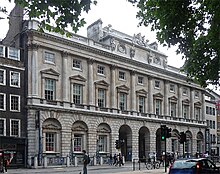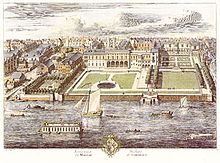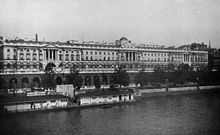Somerset House

Somerset House is a large building located on the south side of The Strand in central London . It overlooks the River Thames in close proximity to Waterloo Bridge . The central part of the classical building, a project by the architect Sir William Chambers , was erected in 1776 and 1796. It was later expanded to include north and south wings in the Victorian style. A building with the same name was built on the same site two centuries earlier. The east wing of the building is part of King's College London .
history
16th Century
In the 16th century, the north bank of the Thames between London and Westminster was the preferred location for residences of the nobility. In 1539 Edward Seymour, 1st Duke of Somerset , Earl of Hertford, received land on Chester Place, next to Temple Bar , in London from Henry VIII. As his successor Edward VI. In 1547 inherited the throne, Seymour was made Duke of Somerset and Lord Protector . In 1549 he had several houses demolished there in order to build an imposing residence. He paid little attention to neighboring buildings, especially some monastery buildings of St Paul's Cathedral , which were removed at the behest of Seymour and other Protestant nobles in the course of the dissolution of the English monasteries . The new building was two-story with a three-story gate tower and enclosed a square inner courtyard. It was one of the first examples of English Renaissance architecture . The architect of the building is unknown.
Before it could be completed, Seymour had already made many enemies in the Privy Council , so he lost the power struggle and was executed in the Tower in 1552 . "Somerset Place", as it was now called, came into royal possession and served as the residence of Princess Elizabeth for several years until her coronation in 1558. It was now officially a royal palace. It took a long time before the building was finally completed. In 1598 the historian John Stow recorded the building as "not yet completed".
17th century

In the 17th century the wives of kings Jacob I , Karl I and Karl II resided there .
Anna , wife of Jacob I, named the residence "Denmark House". She commissioned some expensive additions and improvements. The architect Inigo Jones received some orders . Between 1630 and 1635 he built a chapel in which Henrietta Maria of France , wife Charles I, could practice her Catholic religion. The chapel was looked after by the Capuchin Order and was located in the southwest corner of the large inner courtyard. There was a small cemetery next to the chapel. Some of the tombstones can still be seen today as they were later worked into the walls of the house.
The residence of royal residents was initially interrupted by the English Civil War. In 1649 the parliament decided to sell the building, but no buyer was found. However, the sale of the interior brought in the impressive sum of £ 118,000 at the time. The building was still used. Part of it served as army headquarters for General Fairfax , Commander in Chief of the Parliamentary Army ; other areas served as accommodation for various nobles. In 1658 Oliver Cromwell's body was laid out in Somerset House.
Two years later, during the Stuart Restoration , Henrietta Maria returned and began an extensive renovation program in 1661. The focal point was a new, spacious house front facing the Thames based on old plans by Inigo Jones, who died in Somerset House in 1652. It returned to France before it was completed in 1665.
Subsequently, Katharina von Braganza , the wife of King Charles II, occasionally lived there . During this time, the palace gained a certain public fame as the nucleus for Catholic conspiracies. The English clergyman Titus Oates took advantage of this prejudice and used it for his fictional papist conspiracy . It was also alleged that the murder of Sir Edmund Berry Godfrey, one of the most famous unsolved crimes of the day, took place at Somerset House. The body was then smuggled out of the house and placed in a ditch near Primrose Hill .
In 1685 Somerset House was renovated by Sir Christopher Wren . After the Glorious Revolution in 1688, the residence entered a period of decline and was used as accommodation for members of the royal court. At the time, this meant that hardly any money was invested in building maintenance and it began to fall apart.
During the 18th century these residents also disappeared, and although the imposing Thames facade was even painted twice by Canaletto during his stay in England, it fell into disrepair. It was used as a warehouse, accommodation for foreign dignitaries and as barracks. Eventually it was so dilapidated that it was demolished in 1775.
Sir William Chambers Somerset House

In the mid-18th century, London's lack of representative public buildings was criticized. Ministries and scientific societies were scattered across the city in a multitude of small buildings. Compared to other European metropolises, one did not feel adequately equipped. Politician Edmund Burke was the leading proponent of a national building program, and so Parliament passed a law in 1775 "Establishing and Developing Public Offices in Somerset House and Fortifying Parts of the Thames Boundaries of the Savoy Hotel".
Sir William Chambers was hired to design and build the new Somerset House for £ 2,000 a year. From 1775 he was busy with the construction for the last two decades of his life. Even Thomas Telford , then still Steinmetz, later a noted civil engineer, worked at Somerset House as well as the architect Thomas Hardwick , who spent his formative years there. Hardwick later wrote a short biography about William Chambers. In 1780 the street facade to the beach was finished. The design was based on Inigo Jones' old plans for the river front of the old Somerset House.
It is not known exactly how long the construction work took, but the war with France resulted in financial bottlenecks and construction delays. When Chambers died in 1796, James Wyatt completed the building. It is known that construction was still ongoing in 1801, and there is evidence that renovation work was still to be done in 1819. The building (excluding the New Wing and King's College London behind the west and east wings) cost around £ 500,000 at the time.
As long as the bank of the Thames was not paved, smaller boats could dock through three large arched gates directly in the building.
19th century
As great as the building looked, it wasn't what Chambers had planned it to be. He wanted to build two additional wings to the west and east of the courtyard. The cost had prevented this. Finally, from 1829 to 1834, King's College London was built to the east. The properties were sold on condition that they approximate Chambers' plans in appearance and style. Since land was scarce in the city, the western part was also built with houses in which members of the Admiralty who worked in the south wing were to live. Between 1851 and 1856, these houses were demolished and another wing was built. This part is still called the "New Wing" today.
The building was home to various scientific societies, including the Royal Academy of Arts , which William Chambers had promoted, and the Royal Society and the Society of Antiquaries . The University of London also occupied some rooms.
20th century until today

Somerset House was also damaged during World War II. In addition to minor damage to the facade from nearby explosions, 16 rooms in the south wing and the stairwell of the rotunda (the Nelson Stairs) were completely destroyed. Furthermore, 27 rooms in the west wing were damaged by a direct bomb hit in October 1940. Until the end of May 1941 there was still minor damage to the windows and the balustrades.
It was not until 1950 that the damage to the south wing was repaired as the stone carving was difficult and professionals were difficult to come by after the war. The architect Sir Albert Richardson was commissioned to carry out the reconstruction, which was completed in 1952 for £ 84,000 (then).
Use as a government building
One of the first government agencies to move into Somerset House was the Admiralty, which led to legend that Horatio Nelson worked there temporarily. But there is no evidence of this, although his older brother Maurice was employed there. But there is still a "Nelson room" with a copy of Nelson's will on the wall.
In the course of the next few centuries, various public authorities such as the registration office, archives, laboratories and especially tax authorities changed. These occupied much of Somerset House until the 1970s. In 2004, it was considered whether the then-founded Supreme Court of Great Britain should move into the New Wing. But it was decided against it.
A house for art and education

Towards the end of the 20th century Somerset House developed into a center of fine arts. The Courtauld Institute of Art , including the Courtauld Gallery , which has an important collection of Old Masters and Impressionist paintings, is located here. The courtyard has been used as a parking lot for government employees and the river terrace has been opened to the public. In the part of the building with a view of the Thames there is a visitor center with an audiovisual exhibition about the building's history. There you will also find the mayor's official state barge, as well as a souvenir shop and a café.
The Gilbert Collection with its arts and crafts collection and the Hermitage rooms , in which loans from the Hermitage in St. Petersburg were shown, were also found there. The last Hermitage exhibition was in 2007: The Gilbert Collection closed in 2008, the collection moved to the Victoria and Albert Museum in 2009 . Somerset House's showrooms are now used for temporary exhibitions.
In winter, the inner courtyard is converted into an ice rink, while fountains are operated there in summer. Concerts are also held there.
Film set
Somerset House is occasionally used as a film and television backdrop. In addition to New Year's Eve shows, an episode of the television series Spooks was filmed there and Somerset House was converted into Buckingham Palace .
In 2008 Somerset House was one of the locations in the drama The Duchess, starring Keira Knightley and Ralph Fiennes . Also in 2008, scenes of were there Guy Ritchie -Streifens Sherlock Holmes (2009) with Jew Law and Robert Downey Jr. turned in the same year for the love of film Last Chance Harvey with Dustin Hoffman and Emma Thompson . In spring 2015, the action film London Has Fallen (2016) was shot there.
literature
- John Stow : A Survey of London. Reprinted from the Text of 1603. Edited by Charles Lethbridge Kingsford. 2 volumes. Clarendon, Oxford 1908, see “Somerset House” register (digitized) .
- Mary Cathcart Borer: The City of London. A history. McKay, New York 1977, p. 156.
- Simon Thurley among others: Somerset House. The Palace of England's Queens 1551-1692. London Topographical Society, London 2009, ISBN 9780902087552 .
Web links
Individual evidence
- ↑ PICTURED: Helicopter makes dramatic landing at Somerset House . In: Mail Online . ( dailymail.co.uk [accessed February 12, 2018]).
Coordinates: 51 ° 30 ′ 39.5 ″ N , 0 ° 7 ′ 2 ″ W.



